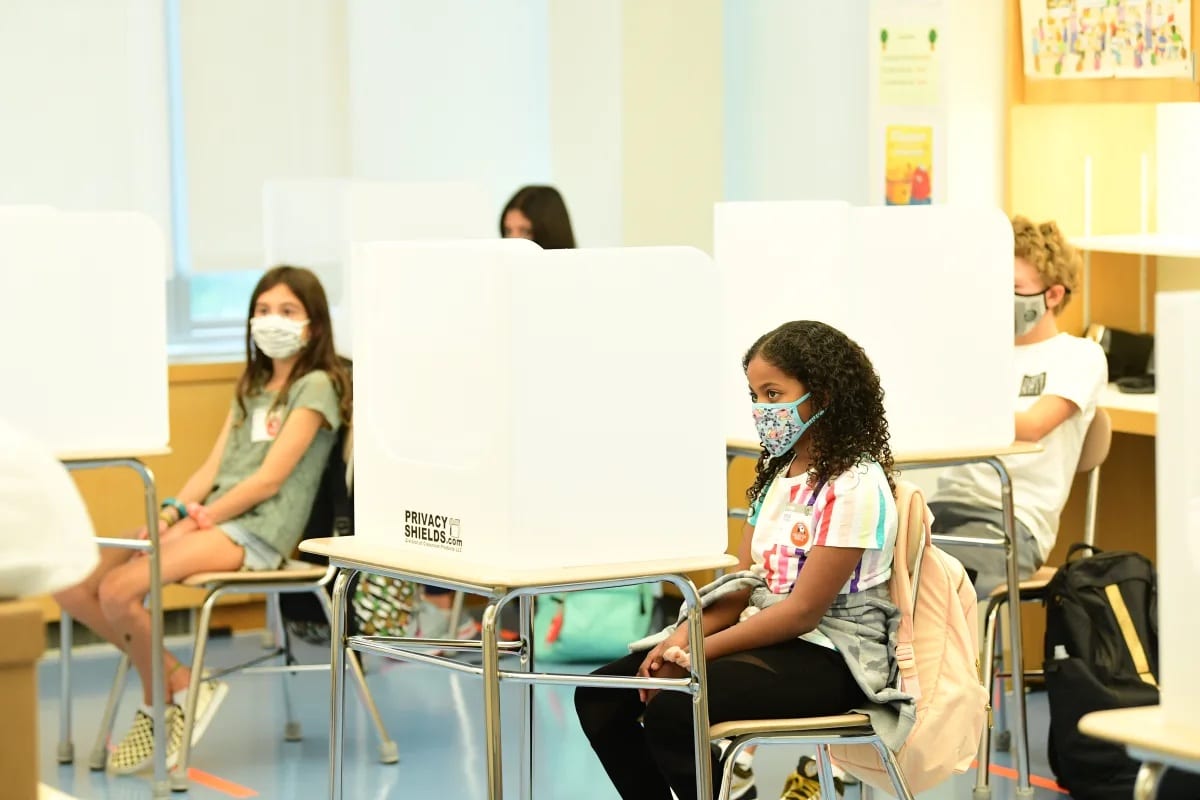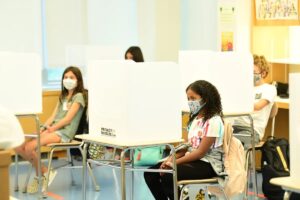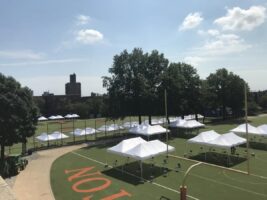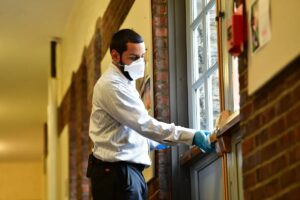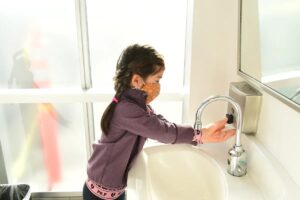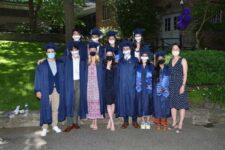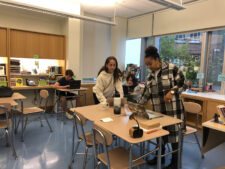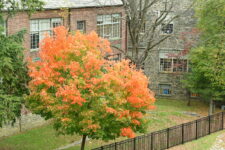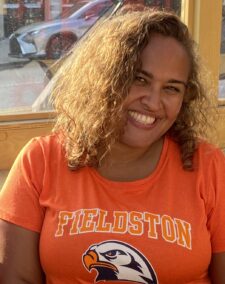On March 10, 2020, when COVID-19 warnings from public health authorities forced ECFS to close its campuses, many in the school community were uncertain what the future would bring. A four-day closure in the week leading up to Spring Recess soon evolved into a semester of fully remote learning as New York went into lockdown and school buildings throughout the city remained shuttered.
However, thanks to a concerted collaborative effort between all constituencies, ECFS transitioned from building the framework for fully remote learning in the spring to welcoming students back to campus in the fall — and all while staying true to its mission of providing an ethical, progressive education. Here’s a look at what happened to reopen the School.
If you’d asked anyone a year ago, the idea of moving ECFS to a fully remote learning environment would be unfathomable. As Director of Technology Jeannie Crowley explains, migrating an organization’s systems online — especially at an institution as complex as a Pre-K–12th Grade school — is a process that normally takes years. With the onset of the COVID-19 pandemic, Crowley and her team only had Spring Recess: a grand total of two weeks.
Thankfully, ECFS wasn’t starting from scratch. “In a lot of ways, we were really lucky as a school,” says Crowley. “We had a lot of things already in place. Our systems are all already hosted externally. Most of our faculty already have their own laptops.” The technology best practices that Crowley’s team has built over the years gave the School a comfortable position to start with.
Still, what remained was a monumental task. Teachers and students needed to learn how to use a dizzying array of new tools and technology. The rapidly evolving pandemic necessitated a dedicated microsite that could be updated in real time. To ensure that every student and faculty member had access to a device for remote learning, the Technology team shipped over 300 Chromebooks. With schools across the city scrambling to gather supplies for their own populations, bulk orders were out of the question, and Crowley had to track down laptops and other accessories piecemeal.
The logistical hurdles of moving ECFS online proved to be just one challenge; from a pedagogical angle, the School was facing some serious questions. For years, teachers, administrators, and technology specialists had cautioned against over-reliance on technology. They had also advocated a differentiated approach to teaching that would accommodate various learning styles among students. Could a virtual mode of education coexist with the School’s philosophy?
The answer, it turned out, was to trust the faculty at ECFS to do what they do best: design a progressive curriculum. Across all grade levels, entire units — many of which had been developed over months and years — were shelved or reimagined wholesale as teachers devised new lesson plans that could work in an online environment. Access to a wood shop or specialized gym equipment might not be possible, for example, but students were more than capable of building three-dimensional structures from cardboard and paper, or of doing a cardiovascular workout in their living rooms. Small-group breakouts and one-on-one check-ins were built into daily and weekly schedules to ensure the student-to-student and student-to-teacher interactions that are critical to student growth remained. And where screen time was unavoidable, teachers would communicate expectations clearly so that students could engage responsibly with technology.
By the time they entered Summer Recess, students and faculty had finished a semester of remote learning unprecedented in the 142-year history of the School.
The successful close of the spring semester offered a moment of respite before bringing on another daunting task: reopening campuses safely in the fall.
From the outset, ECFS’s top priority was to figure out how it could return students and teachers to the classroom while protecting their health and well-being. No matter how sophisticated remote learning technology would become in the coming months, the School knew that in-person learning would offer a better experience.
Preparations for the following academic year began even as the spring semester was proceeding. “We really spent March, April, and even May understanding from local public health officials what the status of the virus transmission was in the area,” explains Kyle Wilkie-Glass, Chief Operating Officer & Assistant Head of School for Strategic Initiatives. “It was a herculean effort across all the School’s constituencies to see where we would go.”
“It was a herculean effort across all the School’s constituencies to see where we would go.”
In May, the School assembled a COVID-19 Pandemic Response Task Force to map out how the ensuing academic year might look under three possible scenarios: operating as normal, operating with modifications, and operating while fully remote. Its work culminated in a comprehensive reopening plan covering everything from daily pre-arrival questionnaires to health and safety training, physical distancing, and mandatory mask-wearing to disinfection and air filtration.
Two subgroups of the task force focused on how to refine a partially or fully remote education for students from Pre-K to 12th Grade. To ensure an equitable learning environment, whether on-campus or off, the subgroups recommended a hyflex model whereby students and teachers could actively participate in classes remotely via Google Meet while their classmates or proctors met in person. They also recommended that schedules balance synchronous and asynchronous learning to reduce screen time and allow for more student and faculty interaction, and that teachers implement more diverse methods of academic feedback and assessment. Prioritizing the social-emotional well-being of students was paramount, so the model for the new academic year would include more structured student orientations, a focus on welcoming new students and families, longer transition times between classes, and regular support periods for both social and academic check-ins.
Planning for a reopening months in the future — even as pandemic conditions shifted daily — carried a hefty degree of uncertainty, but the task force drew on the latest research, their collective years of experience, and guidance from the Centers for Disease Control and Prevention (CDC) and the New York State Department of Health to inform their decisions. Their efforts paid off. “We had to make some pretty big assumptions about where we would be landing with governmental guidance and what the guidelines would allow,” says Wilkie-Glass. “When we saw the New York guidance come out in mid- July, we looked back, and we saw that many of our adjustments were on target.”
“The magnitude of the work we’ve done to accomplish a CDC-appropriate teaching and learning environment, including all the tents that we had on the fields and all the isolation and all the distancing — it’s just been an unbelievable amount of work that we’ve performed,” says Piselli.
Alcivar notes that the hundreds of hours spent determining how to reopen campus allowed the Facilities team to participate in conversations about ECFS’s mission and demonstrate their commitment to its values. “Having our School really focused on what’s important — what are the needs and how do we take care of each other — has been really uplifting,” she says. “Figuring out how we make the School safe for the students first and foremost has been a really good place for centering conversations and for really understanding each other’s beliefs and thought processes.”
Having our School really focused on what’s important — what are the needs and how do we take care of each other — has been really uplifting.
In the weeks leading up to the fall, the many support teams at ECFS worked behind the scenes to meet any unexpected problems head-on. When the School’s contract with its former bus provider ended, ECFS found another, Selby Transportation Corp., whose rigorous attention to hygiene and customer service was met with glowing reviews. A shipment of video cameras due for late August was back-ordered, leading to a heroic rush at the eleventh hour to source replacements from a vendor in Houston, in time for teachers returning to campus to test out their equipment.
The green light from public health authorities to hold school in person came, and ECFS was ready. “It wasn’t a scramble at that point because we’d been organizing all summer,” says Lundgren.
Since September, following a phase-in schedule, ECFS has reopened its campuses, welcoming all families who wish for their students to return to campus. Though the School is a bit less bustling than usual, the hallways still resonate with the sounds of discussions and laughter.
Keeping the campuses open requires constant vigilance. As Director of Campus Services Teddy O’Rourke explains, “We’re looking at guidance from the New York State Department of Health, the New York State Department of Education, the CDC, New York City. We’re constantly poring over the information and trying to see what applies to ECFS, and how we can make adjustments to the program that comply with the guidelines. That’s a constant process. It’s happening almost on a daily basis.”
Among the regular parts of life at ECFS now is on-campus COVID-19 testing, a program spearheaded by Liz English, Executive Assistant to the Chief Operating Officer. In lieu of the more commonly used nasopharyngeal swab, which is difficult to administer on young students, the School has partnered with EverPoint Health to use a test that only requires a 2mL saliva sample, which scales well to large populations and offers rapid turnaround of results. ECFS has run more than 4,000 tests since the start of the academic year.
With expanded nurses’ offices, extensive contact tracing training for nurses and Operations Department staff, and a robust notification system for families, the School has also developed contingency plans should a student or faculty member fall ill.
To ensure the sanitation of the School, the Facilities Department continues to use a healthcare-grade bactericidal, virucidal, and fungicidal cleaner to deep-clean all facilities, including high-touch surfaces, throughout the day. In addition, individual classrooms are stocked with sanitation supplies and personal protective equipment, including alcohol wipes, hand sanitizer, face masks, and disposable gloves, and signage indicating both physical distancing and personal hygiene requirements is posted prominently at all campus entrances. At night, all spaces are sanitized with electrostatic sprayers, a precautionary step that goes above and beyond public health requirements.
Some of the most innovative learning experiences have emerged as the faculty take full advantage of abundant outdoor space available on or near both campuses. At Ethical Culture, teachers use Central Park for activities as diverse as PE and science and story time. On the Fieldston campus, tents on both activity fields create ventilated spaces that can accommodate both small groups at lunch and grade-wide orientations. Even where classes remain virtual, creativity abounds. Fieldston Upper’s Theatre Department has hosted a series of plays performed entirely online, blurring the lines between theatre and film and bringing ECFS’s performing arts to the bleeding edge. This year’s Open School Nights — the marquee curricular nights that bring families on campus to experience a condensed version of their students’ school day — were conducted online, to resounding success.
For all the changes that have occurred at ECFS, the faculty, staff, and administration are just doing the work they’ve always excelled in. “We open the doors and turn on the lights in the morning and shut the doors and turn off the lights at night,” says Piselli. “The maintenance of the buildings and the operations still go on in the middle of taking all the COVID-19 requests that go on all day long.”
As Crowley explains, every effort made boils down to a desire to provide the best possible education for students. “All of this is in service of being able to preserve this comfort zone for kids, where they feel like, ‘I’m just coming to school.’”
